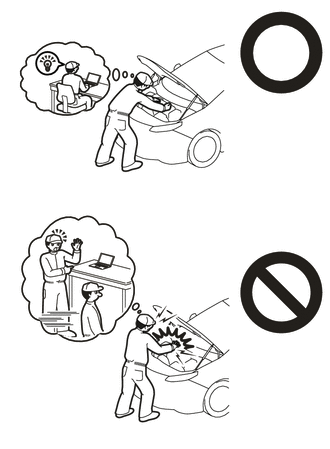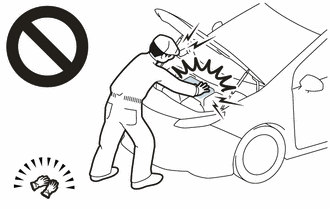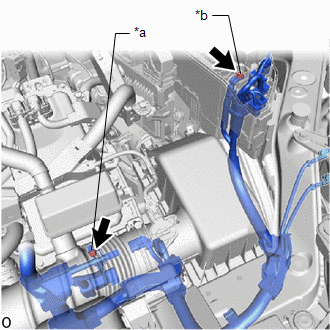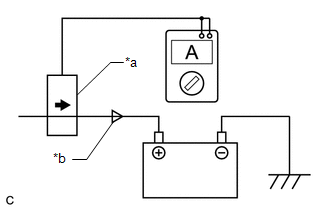| Last Modified: 01-30-2024 | 6.11:8.1.0 | Doc ID: RM1000000026RL8 |
| Model Year Start: 2023 | Model: RAV4 HV | Prod Date Range: [10/2022 - 10/2023] |
| Title: A25A-FXS (BATTERY / CHARGING): CHARGING SYSTEM: ON-VEHICLE INSPECTION; 2023 MY RAV4 HV [10/2022 - 10/2023] | ||
ON-VEHICLE INSPECTION
CAUTION / NOTICE / HINT
The necessary procedures (adjustment, calibration, initialization, or registration) that must be performed after parts are removed and installed, or replaced when inspecting auxiliary battery are shown below.
Necessary Procedure After Parts Removed/Installed/Replaced
|
Replacement Part or Procedure |
Necessary Procedure |
Effect/Inoperative Function when Necessary Procedure not Performed |
Link |
|---|---|---|---|
| *: When performing learning using the Techstream. | |||
|
Auxiliary battery terminal is disconnected/reconnected |
Perform steering sensor zero point calibration |
Lane control system |
|
|
Parking support brake system (for HV model)* |
|||
|
Pre-collision system |
|||
|
Reset back door close position |
Power back door system (for HV model) |
||
|
Back door lock initialization |
Power door lock control system |
||
NOTICE:
- After the ignition switch is turned off, the audio and visual system records various types of memory and settings. As a result, after turning the ignition switch off, make sure to wait at least 2 minutes before disconnecting the cable from the negative (-) auxiliary battery terminal.
- When the cable is disconnected from the negative (-) auxiliary battery terminal and the security lock setting has been enabled, multi-display operations will be disabled upon next startup unless the password is entered. Be sure to check the security lock setting before disconnecting the cable from the negative (-) auxiliary battery terminal.
PROCEDURE
1. CHECK AUXILIARY BATTERY
(a) Check that the auxiliary battery cables are connected to the correct terminals.
If they are not, connect them properly.
(b) Check the auxiliary battery for damage and deformation. If severe damage, deformation or leakage is found, replace the auxiliary battery.
2. CHECK AUXILIARY BATTERY VOLTAGE
(a) Turn the ignition switch off and turn on the high beam headlights for 30 seconds. This will remove the surface charge from the auxiliary battery.
(b) Measure the auxiliary battery voltage according to the value(s) in the table below.
|
Tester Connection |
Condition |
Specified Condition |
Result |
|---|---|---|---|
|
Positive (+) auxiliary battery terminal - Negative (-) auxiliary battery terminal |
20°C (68°F), Ignition switch off |
12.0 V or higher |
Auxiliary battery is OK |
|
12.0 V or less |
Recharge auxiliary battery |
3. RECHARGE AUXILIARY BATTERY
(a) Recharge the auxiliary battery.
HINT:
- Recharge the auxiliary battery according to the charger's instructions.
- Apply the appropriate charging current according to the type of auxiliary battery shown in the table below.
|
Charge Method |
Charging Current |
|---|---|
|
Normal |
Below 5 A |
|
Quick |
Below 15 A |
(b) Turn the ignition switch off and turn on the high beam headlights for 30 seconds. This will remove the surface charge from the auxiliary battery.
(c) Measure the auxiliary battery voltage according to the value(s) in the table below.
|
Tester Connection |
Condition |
Specified Condition |
Result |
|---|---|---|---|
|
Positive (+) auxiliary battery terminal - Negative (-) auxiliary battery terminal |
20°C (68°F), Ignition switch off |
12.0 V or higher |
Auxiliary battery is OK |
|
12.0 V or less |
Recharge auxiliary battery |
4. CHECK AUXILIARY BATTERY TERMINAL, FUSIBLE LINK AND FUSE
(a) Check that the auxiliary battery terminals are not loose or corroded.
Torque:
Positive (+) Auxiliary Battery Terminal :
5.4 N·m {55 kgf·cm, 48 in·lbf}
Negative (-) Auxiliary Battery Terminal :
5.4 N·m {55 kgf·cm, 48 in·lbf}
If a terminal is loose or corroded, tighten or clean the terminal.
(b) Measure the resistance of each fusible link and fuse for the auxiliary battery charging system.
Standard resistance:
Below 1 Ω
If the result is not as specified, replace the fusible link or fuse as necessary.
5. CHECK AMD TERMINAL
CAUTION:
(a) Remove the service plug grip.
(b) Check that the AMD terminal is connected securely, and there is no contact problem.
If there are any arc marks, replace the affected parts.
|
(c) Check that the nut for the AMD terminal is tightened to the specified torque. Torque: Inverter with Converter Assembly Side : 10 N·m {102 kgf·cm, 7 ft·lbf} No. 1 Engine Room Relay Block and No. 1 Junction Block Assembly Side : 8.0 N·m {82 kgf·cm, 71 in·lbf} If there are no arc marks and the AMD terminal connection is faulty, connect the AMD terminal securely. |
|
(d) Install the service plug grip.
6. CHECK DC/DC CONVERTER FUNCTION
|
(a) Connect the AC/DC 400 A probe to the positive (+) auxiliary battery cable. |
|
(b) Turn the ignition switch to on (READY) and leave the vehicle as is until the electric current flowing to the auxiliary battery becomes 10 A or less.
(c) Turn on the high beam headlights, and turn the blower motor switch to the HI position and the rear window defogger on.
|
(d) Measure the current and voltage according to the value(s) in the table below. Result:
If the result is not as specified, replace the inverter with converter assembly. |
|
|
|
|
![2023 MY RAV4 HV [10/2022 - 10/2023]; PARK ASSIST / MONITORING: PARKING SUPPORT BRAKE SYSTEM (for HV Model): CALIBRATION](/t3Portal/stylegraphics/info.gif)




